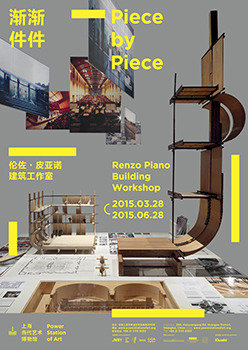Renzo Piano
dal 27/3/2015 al 27/6/2015
Segnalato da
27/3/2015
Renzo Piano
Power Station of Art, Shanghai
This exhibition explores the relations among material, structure, atmosphere and inhabitants of this italian master architect.

"It is very difficult to successfully exhibit architecture. Nothing can really substitute actually being in the building itself, the feeling of the hybrid texture of a city, the continuous stream of voices that make up the sounds of life. An architectural exhibition can, however, clearly transmit something of the complex and shared process through which the buildings we design are conceived, constructed and then inhabited. The exhibition is therefore a partial vision, consisting of the designs, materials and tools that made up this painstaking process, those that you would find on an architect's workbench. An exhibition can also talk about the range of elements that make up our trade as architects: the tests conducted and progress made, but also our changes of direction and disappointments. The way in which an exhibition is presented can, by implication, also communicate a style, or language, an expressive intent. For us this expression is something we call 'the poetry of lightness,' of lighting and of movement."
–Renzo Piano
Established on October 1, 2012, the Power Station of Art (PSA) is the first state-run museum dedicated to contemporary art in mainland China. It is also home to the Shanghai Biennale.
Since 2013, the Power Station of Art has set "architecture and space" as an important academic research direction, presenting thematic exhibitions, symposiums and practice projects each year, and meanwhile preparing to establish an architecture document database. Piece by Piece: Renzo Piano Building Workshop is the second large-scale exhibition of this project, and also the first retrospective of this Pritzker Architecture Prize winner in mainland China.
Renzo Piano believes that a master builder is someone responsible, authoritative, a man focused on his work who invents something new every day and then builds it with his own hands. Then there’s the search for lightness, the idea of constructing something weightless. If he will use the idea of designing with immaterial elements such as lightness, and also transparency, light and its vibrations, shadows, or sounds. Used together, these elements can contribute to defining a space in much the same way as shape and volume do.
It's believed this exhibition would bring enormous enlightenment and inspiration to young Chinese architects. This exhibition not only explores the relations among material, structure, atmosphere and inhabitants, but also manifests the inexorable process of this master architect setting out from Milan modernism, exceeding traditions, infinitely approaching precision and freedom of poem.
About Renzo Piano and RPBW
Renzo Piano was born into a family of builders in Genoa, in 1937. In 1981, he established "Renzo Piano Building Workshop." RPBW has designed buildings all around the world: the Menil Collection in Houston, the terminal for Kansai International Airport in Osaka, the extension of the Morgan Library in New York, the Maison Hermès in Tokyo, the New York Times headquarters, the California Academy of Sciences in San Francisco, the Modern Wing of the Art Institute of Chicago, the London Bridge Tower (The Shard) in London, etc. He has received numerous awards and recognitions including the Royal Gold Medal, 1989; the Goodwill Ambassador of UNESCO, 1994; the Praemium Imperiale, 1995; the Pritzker Architecture Prize, 1998; and the Gold Medal AIA, 2008.
Opening: saturday 28 march 2015
Power Station of Art
200 Huayuangang Rd Shanghai China
Opening Hours
Hours: Tuesday–Sunday 11–19h
Free admission



